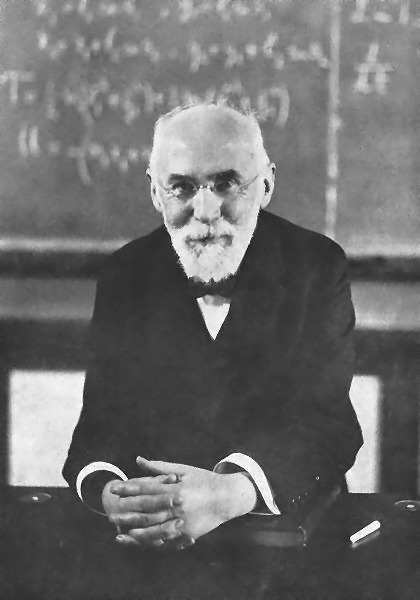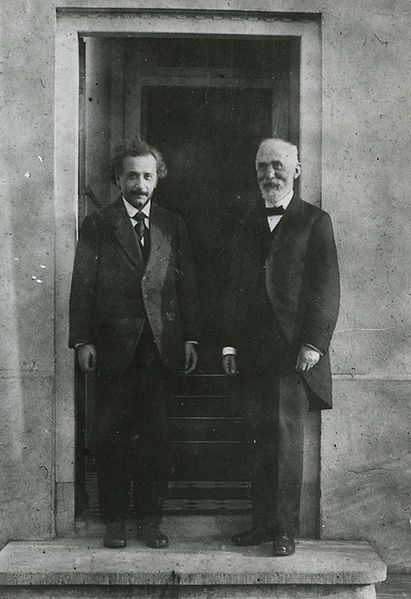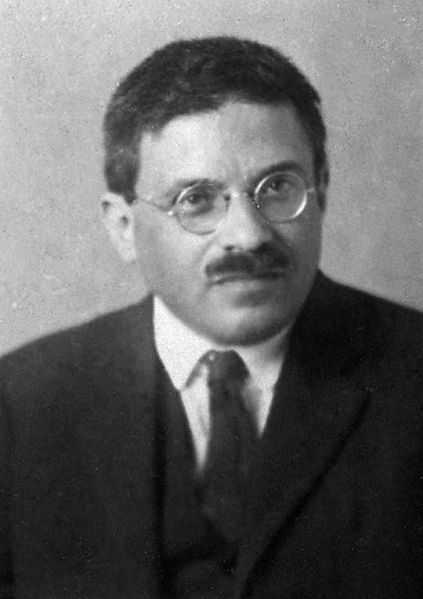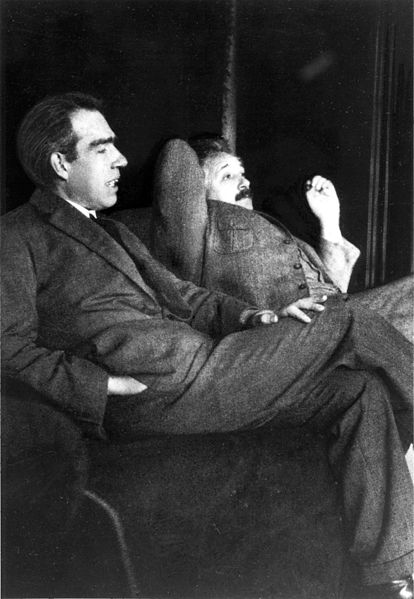<Back to Index>
- Physicist Hendrik Antoon Lorentz, 1853
- Physicist Paul Ehrenfest, 1880
PAGE SPONSOR


Hendrik Antoon Lorentz (18 July 1853 – 4 February 1928) was a Dutch physicist who shared the 1902 Nobel Prize in Physics with Pieter Zeeman for the discovery and theoretical explanation of the Zeeman effect. He also derived the transformation equations subsequently used by Albert Einstein to describe space and time.
Hendrik Lorentz was born in Arnhem, Gelderland (The Netherlands), the son of Gerrit Frederik Lorentz (1822 – 1893), a well off nurseryman, and Geertruida van Ginkel (1826 – 1861). In 1862, after his mother's death, his father married Luberta Hupkes. From 1866 - 1869 he attended the newly established high school in Arnhem, and in 1870 he passed the exams in classical languages which were then required for admission to University.
Lorentz studied physics and mathematics at the University of Leiden, where he was strongly influenced by the teaching of astronomy professor Frederik Kaiser; it was his influence that led him to become a physicist. After earning a bachelor's degree, he returned to Arnhem in 1872 to teach high school classes in mathematics, but he continued his studies in Leiden in addition to his teaching position. In 1875 Lorentz earned a doctoral degree under Pieter Rijke on a thesis entitled "Over de theorie der terugkaatsing en breking van het licht" (On the theory of reflection and refraction of light), in which he refined the electromagnetic theory of James Clerk Maxwell.
In 1881 Hendrik married Aletta Catharina Kaiser, niece of Frederik
Kaiser. She was the daughter of Johann Wilhelm Kaiser, director of the Amsterdam's Engraving School and professor of Fine Arts, and designer of the first Dutch postage stamps (1852). Later Kaiser was the Director of the National Gallery of Amsterdam. Hendrik and Aletta's eldest daughter Geertruida Luberta Lorentz was to become a physicist as well.
In 1878, only 24 years of age, Hendrik Antoon Lorentz was appointed to the newly established chair in theoretical physics at the University of Leiden. On January 25, 1878, he delivered his inaugural lecture on "De moleculaire theoriën in de natuurkunde" (The molecular theories in physics).
During the first twenty years in Leiden, Lorentz was primarily interested in the theory of electromagnetism to explain the relationship of electricity, magnetism and light. After that, he extended his research to a much wider area while still focusing on theoretical physics. From his publications, it appears that Lorentz made contributions to mechanics, thermodynamics, hydrodynamics, kinetic theories, solid state theory, light and propagation. His most important contributions were in the area of electromagnetism, the electron theory and relativity.
Lorentz theorized that the atoms
might consist of charged particles and suggested that the oscillations
of these charged particles were the source of light. When a colleague
and former student of Lorentz, Pieter Zeeman, discovered the Zeeman effect in 1896, Lorentz supplied its theoretical interpretation. The
experimental and theoretical work was honored with the Nobel prize in
physics in 1902. Lorentz' name is now associated with the Lorentz - Lorenz formula, the Lorentz force, the Lorentzian distribution and the Lorentz transformation.
In 1895, with the attempt to explain the Michelson - Morley experiment, Lorentz proposed that moving bodies contract in the direction of motion (length contraction; George FitzGerald had already arrived at this conclusion, FitzGerald - Lorentz Contraction). Lorentz worked on describing electromagnetic phenomena (the propagation of light) in reference frames that moved relative to each other. He discovered that the transition from one to another reference frame could be simplified by using a new time variable which he called local time. The local time depended on the universal time and the location under consideration. Lorentz's publications (of 1895 and 1899) made use of the term local time without giving a detailed interpretation of its physical relevance. In 1900, Henri Poincaré called Lorentz's local time a "wonderful invention" and illustrated it by showing that clocks in moving frames are synchronized by exchanging light signals that are assumed to travel at the same speed against and with the motion of the frame.
In 1899, and again in his paper "Electromagnetic phenomena in a system moving with any velocity smaller than that of light" (1904), Lorentz added time dilation to his transformations and published what Poincaré in 1905 named Lorentz transformations. It was apparently unknown to Lorentz that Joseph Larmor had used identical transformations to describe orbiting electrons in 1897. Larmor's and Lorentz's equations look somewhat unfamiliar, but they are algebraically equivalent to those presented by Poincaré and Einstein in 1905. Lorentz's 1904 paper includes the covariant formulation of electrodynamics, in which electrodynamic phenomena in different reference frames are described by identical equations with well defined transformation properties. The paper clearly recognizes the significance of this formulation, namely that the outcomes of electrodynamic experiments do not depend on the relative motion of the reference frame. The 1904 paper includes a detailed discussion of the increase of the inertial mass of rapidly moving objects. In 1905, Einstein would use many of the concepts, mathematical tools and results discussed to write his paper entitled "On the Electrodynamics of Moving Bodies", known today as the theory of special relativity. Because Lorentz laid the fundamentals for the work by Einstein, this theory was originally called the Lorentz - Einstein theory.
The increase of mass was the first prediction of special relativity to be tested, but the early (1901 – 1903) experiments by Kaufmann appeared to show a slightly different mass increase; this led Lorentz
to the famous remark that he was "at the end of his Latin."
The confirmation of his prediction had to wait until 1908. In 1909,
Lorentz published "Theory of Electrons" based on a series of lectures in
Mathematical Physics he gave at Columbia University.
Poincaré (1902) said of Lorentz's theory of electrodynamics:
- The most satisfactory theory is that of Lorentz; it is unquestionably the theory that best explains the known facts, the one that throws into relief the greatest number of known relations ... it is due to Lorentz that the results of Fizeau on the optics of moving bodies, the laws of normal and abnormal dispersion and of absorption are connected with each other ... Look at the ease with which the new Zeeman phenomenon found its place, and even aided the classification of Faraday's magnetic rotation, which had defied all Maxwell's efforts.
Paul Langevin (1911) said of Lorentz:
- It is the great merit of H. A. Lorentz to have seen that the fundamental equations of electromagnetism admit a group of transformations which enables them to have the same form when one passes from one frame of reference to another; this new transformation has the most profound implications for the transformations of space and time
Lorentz and Emil Wiechert (Göttingen) had an interesting correspondence on the topics of electromagnetism and the theory of relativity, and Lorentz explained his ideas in letters to Wiechert. The correspondence between Lorentz and Wiechert has been published by Wilfried Schröder.
Lorentz was chairman of the first Solvay Conference held in Brussels in the autumn of 1911. Shortly after the conference, Poincaré wrote an essay on quantum physics which gives an indication of Lorentz's status at the time:
- ... at every moment [the twenty physicists from different countries] could be heard talking of the [quantum mechanics] which they contrasted with the old mechanics. Now what was the old mechanics? Was it that of Newton, the one which still reigned uncontested at the close of the nineteenth century? No, it was the mechanics of Lorentz, the one dealing with the principle of relativity; the one which, hardly five years ago, seemed to be the height of boldness.
Albert Einstein (1953) wrote of Lorentz:
- For me personally he meant more than all the others I have met on my life's journey.
While Lorentz is mostly known for fundamental theoretical work, he
also had an interest in practical applications. In the years 1918 - 1926,
at the request of the Dutch government, Lorentz headed a committee to
calculate some of the effects of the proposed Afsluitdijk (Closure Dike) flood control dam on other seaworks in the Netherlands. Hydraulic engineering
was mainly an empirical science at that time, but the disturbance of
the tidal flow caused by the Afsluitdijk was so unprecedented that the
empirical rules could not be trusted. Lorentz proposed to start from the
basic hydrodynamic equations of motion and solve the problem numerically. This was feasible for a "human computer", because of the quasi - one - dimensional nature of the water flow in the Waddenzee. The Afsluitdijk was completed in 1932 and the predictions of Lorentz and his committee turned out to be remarkably accurate. One of the two sets of locks in the Afsluitdijk was named after him.
In 1912, Lorentz retired early to become director of research at Teylers Museum in Haarlem, although he remained external professor at Leiden and gave weekly lectures there. Paul Ehrenfest succeeded him in his chair at the University of Leiden, founding the Institute for Theoretical Physics which would become known as the Lorentz Institute. In addition to the Nobel prize, Lorentz received a great many honors for his outstanding work. He was elected a Fellow of the Royal Society in 1905. The Society awarded him their Rumford Medal in 1908 and their Copley Medal in 1918.
Lorentz died in Haarlem, Netherlands. The respect in which he was held in the Netherlands is apparent from O. W. Richardson's description of his funeral:
- The funeral took place at Haarlem at noon on Friday, February 10. At the stroke of twelve the State telegraph and telephone services of Holland were suspended for three minutes as a revered tribute to the greatest man Holland has produced in our time. It was attended by many colleagues and distinguished physicists from foreign countries. The President, Sir Ernest Rutherford, represented the Royal Society and made an appreciative oration by the graveside.
Unique 1928 film footage of the funeral procession with a lead
carriage followed by ten mourners, followed by a carriage with the
coffin, followed in turn by at least four more carriages, passing by a
crowd at the Grote Markt, Haarlem,
from the Zijlstraat to the Smedesstraat, and then back again through
the Grote Houtstraat towards the Barteljorisstraat, on the way to the
"Algemene Begraafplaats" at the Kleverlaan (northern Haarlem cemetery)
has been digitized on Youtube.
Richardson describes Lorentz as:
- [A] man of remarkable intellectual powers ... . Although steeped in his own investigation of the moment, he always seemed to have in his immediate grasp its ramifications into every corner of the universe. ... The singular clearness of his writings provides a striking reflection of his wonderful powers in this respect. .... He possessed and successfully employed the mental vivacity which is necessary to follow the interplay of discussion, the insight which is required to extract those statements which illuminate the real difficulties, and the wisdom to lead the discussion among fruitful channels, and he did this so skillfully that the process was hardly perceptible.
M. J. Klein (1967) wrote of Lorentz's reputation in the 1920s:
- For many years physicists had always been eager "to hear what Lorentz will say about it" when a new theory was advanced, and, even at seventy-two, he did not disappoint them.
- Nobel Prize for Physics (1902)
- Rumford Medal (1908)
- Copley Medal (1918)


Paul Ehrenfest (January 18, 1880 – September 25, 1933) was an Austrian and Dutch physicist, who made major contributions to the field of statistical mechanics and its relations with quantum mechanics, including the theory of phase transition and the Ehrenfest theorem.
Paul Ehrenfest was born and grew up in Vienna in a Jewish family from Loštice in Moravia. His parents, Sigmund Ehrenfest and Johanna Jellinek, ran a grocery store. Although the family was not overly religious, Paul studied Hebrew and the history of the Jewish people. Later he always emphasized his Jewish roots. Ehrenfest excelled in grade school but did not do well at the Akademisches Gymnasium, his best subject being mathematics. After transferring to the Franz Josef Gymnasium, his marks improved. In 1899 he successfully passed the final exams.
He majored in chemistry at the Technische Hochschule, but took courses at the University of Vienna, in particular from Ludwig Boltzmann on his kinetic theory of thermodynamics. These lectures had a profound influence: they were instrumental in stimulating Ehrenfest’s interest in theoretical physics, defined his main area of research for years to come, and provided an example of inspired teaching. At the time it was customary in the German speaking world to study at more than one university and in 1901 Ehrenfest transferred to Göttingen, which until 1933 was an important center for mathematics and theoretical physics. There he met his future wife Tatyana A. Afanasyeva, a young mathematician born in Ukraine and educated in Russia. In the spring of 1903 he met H.A. Lorentz during a short trip to Leiden. In the meantime he prepared a dissertation on Die Bewegung starrer Körper in Flüssigkeiten und die Mechanik von Hertz (The motion of rigid bodies in fluids and the mechanics of Hertz). He obtained his Ph.D. degree on June 23, 1904, in Vienna, where he stayed from 1904 to 1905.
On December 21, 1904 he married Russian mathematician Tatyana Alexeyevna Afanasyeva (1876 – 1964), who collaborated with him in his work. They had two daughters and two sons: Tatyana ('Tanja') (1905 – 1984), also became a mathematician; Galinka ('Galja') (1910 – 1979), became an author and illustrator of children's books; Paul Jr. ('Pavlik') (1915 – 1939), who also became a physicist; and Vassily ('Wassik') (1918 – 1933).
The Ehrenfests returned to Göttingen in September 1906. They would not see Boltzmann again: on September 6 he took his own life in Duino near Trieste. Ehrenfest published an extensive obituary in which Boltzmann’s accomplishments are described. Felix Klein, doyen of the Göttinger mathematicians and chief editor of the Enzyklopädie der mathematischen Wissenschaften, had counted on Boltzmann for a review about statistical mechanics. Now he asked Ehrenfest to take on this task. Together with his wife, Ehrenfest worked on it for several years; the article was not published until 1911. It is a review of the work of Boltzmann and his school, and shows a style all of its own: a sharp logical analysis of the fundamental hypotheses, clear delineation of unsolved questions, and an explanation of general principles by cleverly chosen transparent examples.
In 1907 the couple moved to St Petersburg. Ehrenfest found good friends there, in particular A.F. Joffe, but felt scientifically isolated. Moreover, as an Austrian citizen and of Jewish origin, he had no prospect of a permanent position. Early in 1912 Ehrenfest set out on a tour of German speaking universities in the hope of a position. He visited Berlin where he saw Max Planck, Leipzig where he saw his old friend Herglotz, Munich where he met Arnold Sommerfeld, then Zurich and Vienna. While in Prague he met Albert Einstein for the first time, and they remained close friends thereafter. Einstein recommended Ehrenfest to succeed him in his position in Prague, but that did not work out. This was due to the fact that Ehrenfest declared himself to be an atheist. Sommerfeld offered him a position in Munich, but Ehrenfest received a better offer; at the same time there was an unexpected turn of events. H. A. Lorentz resigned his position as professor at the University of Leiden, and on his advice Ehrenfest was appointed as his successor.
In October 1912 Ehrenfest arrived in Leiden, and December 4 he gave his inaugural lecture Zur Krise der Lichtaether - Hypothese (About the crises of the light - ether hypothesis). He remained in Leiden
for the rest of his career. In order to stimulate interaction and
exchange between physics students he organized a discussion group and a
fraternity called De Leidsche Flesch. He maintained close contact with
prominent physicists within the country and abroad, and invited them to
visit Leiden and give a presentation in his lecture series. Ehrenfest was an outstanding debater, quick to point out weaknesses and summarize the essentials.
In his lectures he would focus on simple models and examples to illustrate and clarify the underlying assumptions. His classes were small, and he made an effort to get to know students who made use of the reading room. Though few of them were accepted as majors in Theoretical Physics, he had long discussions with them almost on a daily basis. According to Einstein: "He was not merely the best teacher in our profession whom I have ever known; he was also passionately preoccupied with the development and destiny of men, especially his students. To understand others, to gain their friendship and trust, to aid anyone embroiled in outer or inner struggles, to encourage youthful talent — all this was his real element, almost more than his immersion in scientific problems". If Ehrenfest felt that there was little more he could teach his students, he would send them to other centers in Europe for more training. He would also encourage them to accept positions abroad.
Among his students were Johannes Burgers, Hendrik Kramers, Dirk Coster, George Uhlenbeck and Samuel Goudsmit, who became famous for jointly proposing the concept of electron spin, Jan Tinbergen, Arend Rutgers, Hendrik Casimir, Gerhard Dieke, Dirk Struik and Gerard Kuiper. His assistants included Yuri Krutkov, Viktor Trkal, Adriaan Fokker, Paul Epstein, and Gregory Breit. Other young foreign scientists who spent an extended period in his laboratory included Gunnar Nordström, Enrico Fermi, Igor Tamm, Oskar Klein, Robert Oppenheimer, Walter Elsasser, Ralph Kronig, Werner Heisenberg, Paul Dirac and David Dennison.
Most of Ehrenfest's scientific papers deal with fundamentals, and seek to clarify single points. His publications are renowned for clarity, by solving paradoxes or by providing clearer descriptions, or are inspiring by posing penetrating questions. His approach to science is best illustrated by what he wrote to Robert Oppenheimer in the summer of 1928, after Oppenheimer invited himself for an extended stay in Leiden: "If you intend to mount heavy mathematical artillery again during your coming year in Europe, I would ask you not only not to come to Leiden, but if possible not even to Holland, and just because I am really so fond of you and want to keep it that way. But if, on the contrary, you want to spend at least your first few months patiently, comfortably and joyfully in discussions that keep coming back to the same few points, chatting about a few basic questions with me and our young people - and without thinking much about publishing (!!!) - why then I welcome you with open arms!! ". Characteristically, he did not like the abstraction of the new quantum theory of Heisenberg and Dirac.
Ehrenfest’s most important contribution from 1912 up to 1933 is the theory of adiabatic invariants. It is a concept derived from classical mechanics that on the one hand can serve to refine certain methods of Bohr's model of the atom (although initially Ehrenfest did not accept Bohr’s ideas) and on the other hand makes a link between atomic mechanics and statistical mechanics. He made major contributions to quantum physics, including the theory of phase transitions and the Ehrenfest theorem, which states that expectation values of a quantum system follow classical mechanics. His name is also given to the Ehrenfest paradox, an apparent paradox in relativity still discussed today, to the Ehrenfest model, and to Ehrenfest Time, the time characterizing the departure of quantum dynamics for observables from classical dynamics.
Ehrenfest was also interested in developing mathematical theories in
economics. This interest was stimulated by his notion that there should
be an analogy between thermodynamics and economic processes. While this
did not result in publications, he did encourage his graduate student
Tinbergen to follow up on this. Tinbergen's thesis was devoted to
problems both from physics and economics, and he went on to become an
economist and was awarded the first Bank of Sweden Prize in Economic Sciences in Memory of Alfred Nobel in 1969.
Ehrenfest was particularly close to Einstein and to Bohr. After Niels Bohr's first visit to Leiden in 1919, for Kramers' thesis defense, he wrote to Ehrenfest: "I am sitting and thinking of all what you have told me about so very many different things, and whatever I think of I feel that I have learned so much from you which will be of great importance for me; but, at the same time, I wish so much to express my feeling of happiness over your friendship and of thankfulness for the confidence and sympathy you have shown me, I find myself so utterly incapable of finding words for it".
On his invitation Einstein accepted in 1920 an appointment as extraordinary professor
at the University of Leiden. This arrangement allowed Einstein to visit
Leiden for a few weeks every year. At these occasions Einstein would
stay at Ehrenfest's home. In 1923 Einstein stayed there for 6 weeks,
after German ultra - nationalists in Berlin had made threats against his
life. On the occasion of the 50th anniversary of Lorentz' doctorate
(December 1925) Ehrenfest invited both Bohr and Einstein over to Leiden,
in an attempt to reconcile their scientific differences about the
emerging quantum theory. These discussions were continued at the 1927 Solvay Conference, where Ehrenfest much to his dismay had to side with Bohr's position in this great debate.
From the correspondence with his close friends of May 1931 it appears that Ehrenfest suffered from severe depression. By August 1932, Einstein was so worried that he wrote to the Board of the University of Leiden, expressing deep concern and suggesting ways in which Ehrenfest's workload could be reduced.
In Amsterdam, on September 25, 1933, he lost his battle with depression. Having made arrangements for the care of his other children, he first shot his younger son Wassik, who had Down syndrome, then killed himself.